How Employee Self-Service (ESS) Portal Benefits HR Resources

The world of human resources (HR) is rapidly evolving, with technology playing a pivotal role in shaping the way companies manage their workforce. One of the most significant advancements in this field is the integration of HR software with Employee Self-Service (ESS) portals. By providing a centralised self-service platform, an ESS Portal not only reduces administrative burdens but also promotes transparency and ownership among your workforce.
What is meant by Employee Self Service (ESS) Portal?
An Employee Self Service (ESS) portal is a secure, web-based platform. It allows employees to access and manage various aspects of their employment information and services independently. The portal serves as a centralized hub for employees. They can perform various HR-related tasks and access relevant data. This is done without relying heavily on human resources personnel.
The primary goal of an ESS portal is to streamline HR processes. It also aims to enhance employee engagement and improve overall operational efficiency within an organization. By leveraging this technology, employees can take control of their personal data. They can submit requests and access relevant information at their convenience. This reduces the administrative burden on HR professionals.
How does an Employee Self Service (ESS) Portal Benefits Employees?
An Employee Self-Service (ESS) Portal benefits employees in several ways:
1. Increased Productivity: ESS portals provide employees with easy access to essential information like company policies, shift timings, and employee documents, reducing time spent searching for information and allowing them to focus on their work.
2. Enhanced Transparency: Employees can access their attendance records, payslips, and other important information, fostering transparency and ensuring that everyone is on the same page regarding schedules and work-related details.
3. Empowerment and Control: ESS portals empower employees by allowing them to manage their own data, such as updating personal information, submitting expense reports, and requesting time off, giving them more control over their information and tasks.
4. Career Development Opportunities: ESS portals often include features for employees to explore career advancement opportunities, apply for internal positions, enroll in training programs, and track their progress, fostering a culture of continuous learning and growth.
5. Improved Communication: By providing a centralized platform for communication, ESS portals enable employees to stay informed about company news, announcements, job openings, and events, enhancing engagement and connectivity within the organization.
Using ESS, employees can access and manage their information at their convenience, fostering a sense of ownership and control over their employment-related matters.
Important Features of Employee Self-Service (ESS) for Businesses
Employee self-service helps businesses streamline operations and increase efficiency by reducing administrative hassles and requiring little effort. Here are some of the most commonly used employee self-service features that businesses leverage through an ESS portal:
1. Employee Data Management:
Allows employees to update personal information, such as contact details and emergency contacts, enhancing data accuracy and reducing administrative tasks.
2. Time and Attendance Tracking:
Enables employees to manage their schedules, request time off, and track leave balances, streamlining workforce management processes.
3. Payroll and Benefits Access:
Provides employees with the ability to view pay stubs, manage benefits enrollment, and access payroll information, improving transparency and employee satisfaction.
4. Communication with HR:
Facilitates direct communication with HR departments, sharing important documents, policies, and enabling employees to seek assistance easily.
5. Mobile Accessibility:
Offers mobile app access for employees to manage tasks on-the-go, enhancing convenience and ensuring accessibility outside of office hours.
6. Document Management:
Centralizes HR documentation, making it easily accessible for employees, improving organization and reducing paperwork.
7. Onboarding Support:
Assists in the onboarding process by providing new hires with access to essential documents, contracts, and company information digitally, ensuring a smooth integration into the organization.
8. Security and Compliance:
Ensures data security through password-protected platforms, limiting access to authorized individuals only, and facilitates compliance with regulations like GDPR.
9. Training and Development:
Offers features for employee development by providing access to training materials, certifications, and career advancement opportunities within the portal.
10. Expense Management:
Simplifies expense tracking by allowing employees to submit expenses digitally and supervisors to approve them efficiently through the portal.
11. Performance Management:
Allows employees to set goals, track progress, and participate in performance reviews, fostering a culture of continuous feedback and improvement.
12. Shift Scheduling:
Enables employees to view their schedules, request shift changes, and manage availability, promoting better workforce planning and flexibility.
13. Recognition and Rewards:
Incorporates features for peer recognition, rewards programs, and employee achievements, boosting morale and motivation within the organization.
14. Survey and Feedback Tools:
Provides mechanisms for employees to give feedback, participate in surveys, and voice concerns, promoting a culture of open communication and continuous improvement.
15. Analytics and Reporting:
Offers insights into employee engagement, utilization of HR services, and trends within the organization, enabling data-driven decision-making and strategic planning.

How to Choose an Employee self-service (ESS) Software?
Choosing an Employee Self-Service (ESS) software involves considering several key factors to ensure its effectiveness and alignment with the organization’s needs. Here are some essential considerations when selecting an ESS software provider:
1. Ease of Use for Employees: Opt for software that is user-friendly and easily navigable for employees, ensuring a seamless experience and high adoption rates.
2. Tailoring to Employee Needs: Choose a software provider that allows customization to match the specific needs of your employees, offering features that are relevant and useful.
3. Integration and Support: Select an ESS software that integrates well with existing systems, offers reliable customer support, and ensures a smooth setup and maintenance process.
4. Security Measures: Prioritize software that emphasizes data security and compliance, with features like encryption techniques, regular security audits, and compliance with industry regulations to protect employee data.
5. Communication and Onboarding: Look for software that facilitates effective communication with HR, shares important documents, and streamlines the onboarding process for new employees.
6. Mobile Accessibility: Consider software that offers mobile access, allowing employees to manage tasks on-the-go and ensuring accessibility outside of office hours.
7. Employee Empowerment: Choose a platform that empowers employees by providing autonomy over their information and tasks, enhancing engagement and productivity levels.
There are numerous compelling reasons why an increasing number of HR teams are embracing Employee Self-Service Portals, People Management Software, Human Capital Management Software (HCMS), Human Resource Management Systems (HRMS), and Human Resource Information Systems (HRIS). These solutions go beyond simply reducing the volume of repetitive emails and phone calls, offering a transformative impact on internal communication and the overall employee experience.



